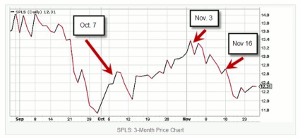While covered call writing and selling cash-secured puts are similar options strategies, Alan Ellman of TheBlueCollarInvestor.com points out that they still have several nuances—such as the ones he highlights—that also make them different.
“Covered call writing and put-selling are exactly the same strategies.” Now you haven’t heard that from me but we have all heard it often enough to wonder why so many believe this. The main reason, the theory goes, is that the risk-reward profiles for both strategies are precisely the same and so that means that the strategies as a whole must be clones. In my humble opinion, they are related, cousins, if you will, not identical twins. In my fifth book, Selling Cash-Secured Puts, I devoted Chapter 15 to this topic, comparing the two strategies, with a comparison chart on page 214. This chart includes both similarities and differences. Whether we are writing covered calls or selling puts, our nemesis is the decline in share price. In both strategies, if share price remains the same, rises, or declines slightly, we win. We only can lose when share price declines significantly. This computes to more than the call premium or more than the out-of-the-money strike minus the put premium, depending on which strategy is being employed. In this article, we will hone on these worst case scenarios and how the inverse impact Delta has on our exit strategy execution for declining stock prices in both strategies.
Staples Chart
We will view a 3-month chart for Staples (SPLS) from September, 2015, through November, 2015:
Note the following SPLS price points:
- October 7: $12.50
- November 3: $13.25
- November 16: 12.60
Exit strategy requirement for a declining stock.
The BCI methodology stresses the importance of remaining pro-active during the contract, buying back the options when opportunities arise for mitigation of losses or enhancement of gains. Since we are focusing on worst case scenarios, let’s view the option charts for the $12.00 in-the-money call option (lower than current market value) and the $12.00 out-of-the-money put option (also lower than current market value):
It is clear from this comparison chart that Delta has an inverse impact on call and put options and frequently can overcome the effect of Theta (time value erosion). To read the entire article click here…
By Alan Ellman of TheBlueCollarInvestor.com




















